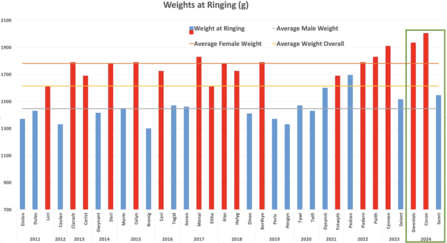Many thanks for all the name suggestions - we had over 200 to pick from. Here are the names we chose with each bird's weight.
🐣 - Chick 1 – 🟦 6B1: Gwenlais (Female - 1935g)
🐣🐣 - Chick 2 – 🟦 6B2: Coron (Female - 2005g)
🐣🐣🐣 - Chick 3 – 🟦 6B3: Senni (Male - 1545g)
So the first two chicks are females and Bobby Bach this year, the younger 'small' one, is a boy.
These are the biggest chicks we've ever recorded at this nest, with Coron being the first we've ever weighed over the 2Kg mark.
Nest Records:
CORON – largest chick ever recorded (2005g)
GWENLAIS – 2nd largest chick ever recorded (1935g)
SENNI – 3rd largest male ever recorded (1545g) out of 17 in all. He is Bobby “Bach”
The table below illustrates just how big these birds are compared to previous years:



